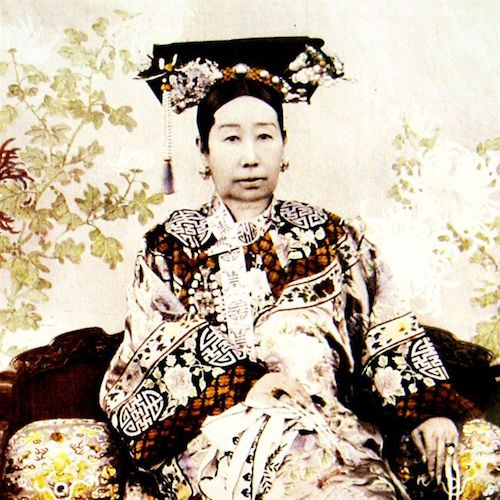
Do you have cushions on which your dog can sleep? She did too.
Have you ever named a dog after one of your favorite people? So did she.
Is your dog’s food almost more expensive than the food you eat? It was the same with her.
Do you have teams of eunuchs looking after your dogs and bathing them? No?
Ok, the similarities probably end there, but even if you do have teams of eunuchs around the house (and if you do, contact us), the fact that she was an empress might be the proverbial nail in the coffin that separates you from the Empress Dowager Cixi.
The Empress, also known as Tzu Hsi, ruled in China from 1861 through 1908, and she regarded her beloved Pekingese dogs as sacred. They lived in marble kennels lined with silk cushions, and they ate only the highest quality food. In fact, a normal lunch for the Empress saw her presented with 128 different dishes (most of which she disregarded or, at best, took a few bites of some) and she demanded no less for her Pekes. They ate the highest grade rice, meat, and were also served sharks’ fins, curlews’ livers and quails’ breasts.
The dogs played in their own courtyard, and their version of a travel crate was a gilded cage made of jade and cloisonné. When it came to accessories, the dogs wore clothes were made from satin and adorned with special floral Malus spectabilis and chrysanthemum patterns, embroidered with silk and gold thread.
Like most of us, she had a heart dog, a Peke named Shadza, which means “Fool,” but she also gifted Pekes to European and American visitors in the course of establishing relationships after the Boxer Rebellion.
And when it came to drawing up a breed standard, she got her way. After all, who’s going to tell the Empress of their country in the 1800s that the line, “let its nose be like that of the monkey god of the Hindus” is idiotic?
The Dowager Empress Tze Hsi of China drew up further points for the Pekingese, and we’ll let you read them for yourself as “Pearls dropped from the lips of Her Imperial Majesty:”
- Let the Lion Dog be small; let it wear the swelling cape of dignity around its neck; let it display the billowing standard of pomp above its back.
- Let its face be black; let its forefront be shaggy; let its forehead be straight and low.
- Let its eyes be large and luminous; let its ears be set like the sails of war junk; let its nose be like that of the monkey god of the Hindus.
- Let its forelegs be bent; so that it shall not desire to wander far, or leave the Imperial precincts.
- Let its body be shaped like that of a hunting lion spying for its prey.
- Let its feet be tufted with plentiful hair that its footfall may be soundless and for its standard of pomp let it rival the whisk of the Tibetans’ yak, which is flourished to protect the imperial litter from flying insects.
- Let it be lively that it may afford entertainment by its gambols; let it be timid that it may not involve itself in danger; let it be domestic in its habits that it may live in amity with the other beasts, fishes or birds that find protection in the Imperial Palace.
- And for its color, let it be that of the lion — a golden sable, to be carried in the sleeve of a yellow robe; or the colour of a red bear, or a black and white bear, or striped like a dragon, so that there may be dogs appropriate to every costume in the Imperial wardrobe.
- Let it venerate its ancestors and deposit offerings in the canine cemetery of the Forbidden City on each new moon.
- Let it comport itself with dignity; let it learn to bite the foreign devils instantly.
- Let it be dainty in its food so that it shall be known as an Imperial dog by its fastidiousness; sharks fins and curlew livers and the breasts of quails, on these may it be fed; and for drink give it the tea that is brewed from the spring buds of the shrub that groweth in the province of Hankow, or the milk of the antelopes that pasture in the Imperial parks.
Thus shall it preserve its integrity and self-respect; and for the day of sickness let it be anointed with the clarified fat of the legs of a sacred leopard, and give it to drink a throstle’s [song thrush] eggshell full of the juice of the custard apple in which has been dissolved three pinches of shredded rhinoceros horn, and apply it to piebald leeches.So shall it remain — but if it dies, remember thou too art mortal.
If you’ve ever had a hand in drawing up or revising a breed standard, we tip our hat to you. It’s not an easy process. And the short answer to our subject line (said tongue in cheek) is that it helps to be the only royal in the room when drawing up a breed standard.
